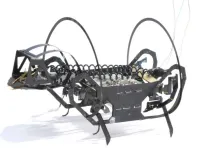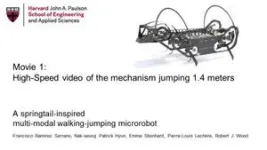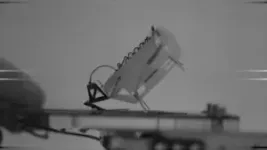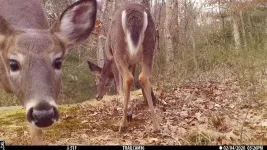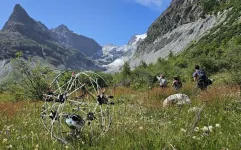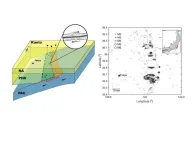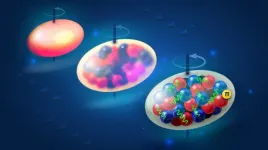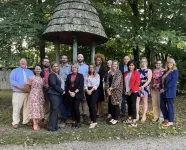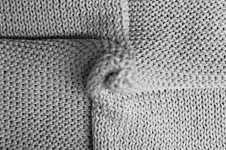(Press-News.org) Springtails, small bugs often found crawling through leaf litter and garden soil, are expert jumpers. Inspired by these hopping hexapods, roboticists in the Harvard John A. Paulson School of Engineering and Applied Sciences (SEAS) have made a walking, jumping robot that pushes the boundaries of what small robots can do.
Published in Science Robotics, the research glimpses a future where nimble microrobots can crawl through tiny spaces, skitter across dangerous ground, and sense their environments without human intervention.
The new Harvard robot was created in the lab of Robert J. Wood, the Harry Lewis and Marlyn McGrath Professor of Engineering and Applied Sciences at SEAS. It is a modification of the Harvard Ambulatory Microrobot (HAMR), a microrobotic platform originally modeled after the dexterous, hard-to-kill cockroach. Now, HAMR is outfitted with a robotic furcula – the forked, tail-like appendage tucked under a springtail’s body that it pushes off the ground to send it Simone Biles-ing into the air.
“Springtails are interesting as inspiration, given their ubiquity, both spatially and temporally across evolutionary scales,” Wood said. “They have this unique mechanism that involves rapid contact with the ground, like a quick punch, to transfer momentum and initiate the jump.”
To go airborne, the robot uses what’s called latch-mediated spring actuation, in which potential energy is stored in an elastic element – the furcula – that can be deployed in milliseconds like a catapult. This physical phenomenon is found time and again in nature, not just in springtails: from the flicking tongue of a chameleon to the prey-killing appendage of a mantis shrimp.
Wood’s team previously created a mantis shrimp-inspired punching robot. “It seemed natural to try to explore the use of a similar mechanism, along with insights from springtail jumps, for small jumping robots,” Wood said.
The springtail’s furcula is also elegantly simple, composed of just two or three linked units. “I think that simplicity is what initially charmed me into exploring this type of solution,” said first author and former SEAS research fellow Francisco Ramirez Serrano.
The team used streamlined microfabrication workflows pioneered in the Wood lab to develop the palm-sized, paper clip-light robot that can walk, jump, climb, strike, and even scoop up objects.
The robot demonstrates some of the longest and highest jumps of any existing robot relative to body length; its best performance is 1.4 meters, or 23 times its length. By contrast, a similar robot can jump twice as far but outweighs the Harvard robot by 20 times.
“Existing microrobots that move on flat terrain and jump do not possess nearly the agility that our platform does,” Serrano said.
The team incorporated detailed computer simulations into the design of the robot to help it land optimally every time, precisely controlling for the lengths of its linkages, the amount of energy stored in them, and the orientation of the robot before takeoff.
Packing all manner of athletic abilities into one lightweight robot has the team excited for a future where robots like theirs could traverse places humans can’t or shouldn’t.
“Walking provides a precise and efficient locomotion mode but is limited in terms of obstacle traversal,” Wood said. “Jumping can get over obstacles but is less controlled. The combination of the two modes can be effective for navigating natural and unstructured environments.”
The research was supported by the U.S. Army Research Office under grant No. W911NF1510358.
END
A springtail-like jumping robot
Diminutive device can leap 23 times its body length
2025-02-26
ELSE PRESS RELEASES FROM THIS DATE:
When the wild things are: URI team reports on mammalian daily activity with surprising results
2025-02-26
KINGSTON, R.I. – Feb. 26, 2025 – Animal antics have captured public attention and viral views across the U.S. in the last few years with the advent of mini cameras that capture the movements of animals in front yards nationwide, from bear to deer.
A University of Rhode Island-based group has taken the camera concept one step further and then some, generating a massive dataset of animal images, not for entertainment, but for science.
When the Global Animal Diel Activity Project results were analyzed, researchers made some unique discoveries.
Put together, researchers across the country and around the world generated a more focused picture of animal ...
Morphing robot turns challenging terrain to its advantage
2025-02-26
From mountain goats that run up near-vertical rock faces to armadillos that roll into a protective ball, animals have evolved to adapt effortlessly to changes in their environment. In contrast, when an autonomous robot is programmed to reach a goal, each variation in its pre-determined path presents a significant physical and computational challenge.
Researchers led by Josie Hughes in the CREATE Lab in EPFL’s School of Engineering wanted to develop a robot that could traverse diverse environments as adeptly as animals by changing form on the fly. With GOAT (Good Over All Terrains) they have achieved just that – and created a new paradigm for robotic ...
New study reveals how rogue planetary-mass objects form in young star clusters
2025-02-26
A groundbreaking study published in Science Advances sheds new light on the mysterious origins of free-floating planetary-mass objects (PMOs)—celestial bodies with masses between stars and planets.
Led by Dr. DENG Hongping of the Shanghai Astronomical Observatory of the Chinese Academy of Sciences, an international team of astronomers used advanced simulations to uncover a novel formation process for these enigmatic objects. The research suggests that PMOs can form directly through violent interactions between circumstellar disks in young star clusters.
The Mystery of Rogue Planetary-Mass ...
School of rock: Properties of rocks in fault zones contribute to earthquake generation
2025-02-26
ANN ARBOR—Earthquakes occur along fault lines between continental plates, where one plate is diving beneath another. Pressure builds between each plate, called fault stress. When this stress builds enough to release, the plates slip and grind against each other, causing an earthquake.
Researchers have long thought that this force is the central driver of earthquakes. But another force is also in the mix: the properties of the rocks in the fault zones along the plate interface. This includes both the structure of the rock as well as how the rocks are arranged along the zones.
Now, a University of Michigan study looking at a small ...
Aston University microbiologist calls for public vigilance and urgent action on the danger of raw sewage in UK seas
2025-02-26
Dr Jonathan Cox writes in Microbiology about the pathogens in raw sewage and the “significant” danger to public health when it ends up in the sea
He contracted a lung infection in 2024, likely from exposure to raw sewage in the sea where he had been swimming
He urges people to check for sewage reports before heading to the beach and calls for investment to improve infrastructure.
Aston University microbiologist Dr Jonathan Cox has written an article for the journal Microbiology on ...
Supercomputing illuminates detailed nuclear structure
2025-02-26
Using the Frontier supercomputer at the Department of Energy’s Oak Ridge National Laboratory, researchers have developed a new technique that predicts nuclear properties in record detail.
The study revealed how the structure of a nucleus relates to the force that holds it together. This understanding could advance efforts in quantum physics and across a variety of sectors, from to energy production to national security.
“Our reliable predictions will bring new insights to the study of nuclear forces and structure,” said Zhonghao Sun of Louisiana State University, formerly of ORNL.
The team’s findings, published in the ...
Ohio tests new model for providing mental health resources to youth in rural communities
2025-02-26
During and after the height of the COVID-19 pandemic, telehealth appointments became a more common part of the American health care system. But even as telehealth options grow, barriers such as long waitlists or a lack of a stable internet connection mean many communities still do not have access to care, particularly for mental health services.
The University of Cincinnati, the Adams County Health Department (ACHD) and other local partners are testing a new collaborative care model that aims to remove these barriers and provide more students access to telemental health care. The team recently received a $1.75 million grant from the Health ...
Breast-conserving surgery improves sexual well-being compared to breast reconstruction
2025-02-26
February 26, 2025 — For women with breast cancer, breast-conserving therapy (BCT) is associated with improved sexual well-being, compared to mastectomy followed by breast reconstruction, reports a study in the March issue of Plastic and Reconstructive Surgery®, the official medical journal of the American Society of Plastic Surgeons (ASPS). The journal is published in the Lippincott portfolio by Wolters Kluwer.
"In our study, patients undergoing BCT scored consistently higher on a measure of sexual well-being, compared to total mastectomy and breast reconstruction," comments Jonas A. Nelson, MD, MPH, of Memorial ...
What can theoretical physics teach us about knitting?
2025-02-26
The practice of purposely looping thread to create intricate knit garments and blankets has existed for millennia. Though its precise origins have been lost to history, artifacts like a pair of wool socks from ancient Egypt suggest it dates back as early as the 3rd to 5th century CE. Yet, for all its long-standing ubiquity, the physics behind knitting remains surprisingly elusive.
“Knitting is one of those weird, seemingly simple but deceptively complex things we take for granted,” says ...
Discovery of rare gene variants provides window into tailored type 2 diabetes treatment
2025-02-26
OKLAHOMA CITY – A new study published in Communications Medicine, a Nature publication, details the discovery of rare gene variants that increase the prevalence of Type 2 diabetes in multiple generations of Asian Indian people. The unusual finding is a step toward more targeted treatment for all people with Type 2 diabetes, a disease with complex genetic influences.
“We wanted to study several generations of Asian Indians because understanding genetics in families can give us better information, and Asian Indians have up to six times higher risk of developing Type 2 diabetes than Europeans. In addition, Asian Indians tend to live clustered together and marry ...
LAST 30 PRESS RELEASES:
Making lighter work of calculating fluid and heat flow
Normalizing blood sugar can halve heart attack risk
Lowering blood sugar cuts heart attack risk in people with prediabetes
Study links genetic variants to risk of blinding eye disease in premature infants
Non-opioid ‘pain sponge’ therapy halts cartilage degeneration and relieves chronic pain
AI can pick up cultural values by mimicking how kids learn
China’s ecological redlines offer fast track to 30 x 30 global conservation goal
Invisible indoor threats: emerging household contaminants and their growing risks to human health
Adding antibody treatment to chemo boosts outcomes for children with rare cancer
Germline pathogenic variants among women without a history of breast cancer
Tanning beds triple melanoma risk, potentially causing broad DNA damage
Unique bond identified as key to viral infection speed
Indoor tanning makes youthful skin much older on a genetic level
Mouse model sheds new light on the causes and potential solutions to human GI problems linked to muscular dystrophy
The Journal of Nuclear Medicine ahead-of-print tip sheet: December 12, 2025
Smarter tools for peering into the microscopic world
Applications open for funding to conduct research in the Kinsey Institute archives
Global measure underestimates the severity of food insecurity
Child survivors of critical illness are missing out on timely follow up care
Risk-based vs annual breast cancer screening / the WISDOM randomized clinical trial
University of Toronto launches Electric Vehicle Innovation Ontario to accelerate advanced EV technologies and build Canada’s innovation advantage
Early relapse predicts poor outcomes in aggressive blood cancer
American College of Lifestyle Medicine applauds two CMS models aligned with lifestyle medicine practice and reimbursement
Clinical trial finds cannabis use not a barrier to quitting nicotine vaping
Supplemental nutrition assistance program policies and food insecurity
Switching immune cells to “night mode” could limit damage after a heart attack, study suggests
URI-based Global RIghts Project report spotlights continued troubling trends in worldwide inhumane treatment
Neutrophils are less aggressive at night, explaining why nighttime heart attacks cause less damage than daytime events
Menopausal hormone therapy may not pose breast cancer risk for women with BRCA mutations
Mobile health tool may improve quality of life for adolescent and young adult breast cancer survivors
[Press-News.org] A springtail-like jumping robotDiminutive device can leap 23 times its body length
